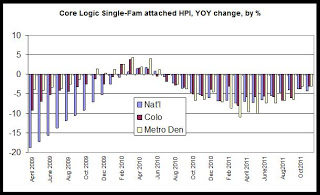Nationally, the index fell 4.32 percent, and it rose 01.01 percent in the Denver-Aurora-Broomfield metro area during the same period.
The first graph shows the year-over-year changes for the past 32 months in the US, Colorado and the Denver metro area. Over the past two years, the general trend in all three areas has been shaped by the home buyer tax credit, which was introduced in 2008 and expired in April 2010. Clearly, home prices climbed throughout the duration of the tax credit period, but declined after the credit's expiration.

During most months in the past two years, the Colorado and metro Denver HPI have performed better (from a property owner's perspective) than the national HPI. The national HPI has declined more than the local HPIs in each month since September 2010.
This data for November suggests that, although the year-over-year declines have lessened in magnitude, home prices have not yet turned around in Colorado as of November 2011. Metro Denver, on the other hand, has now shown a year-over-year increase. The Core-logic HPI for metro Denver is the first home price index among the major national indices that has shown a year over year increase for the region during the past 12 to 15 months. Local Realtor data, as well as the Case-Shiller data, all show that in year-over-year comparisons, home prices continue to fall when compared to the same month in the prior year. However, the Corelogic year-over-year changes are now close enough to zero to suggest that home prices are no longer declining, but are essentially flat in many markets.
New pending home sales data from NAR suggests some new strength in home sales transactions at the regional level in some areas, but in Colorado statewide, home sales activity through November remains about equal with 2009.
See the home price data archive for more.
Corelogic also provides one of the few publicly-available indices that looks at home prices in attached homes such as condos and townhomes. Among attached homes, home prices have fallen significantly more than is the case for all single-family properties. Although the combined single-family Colorado index fell by 0.05 percent, year-over-year for November, the same index for attached housing fell by 3.08 percent. In the metro Denver area, the index for attached homes fell 3.12 percent. As with the single-family combined index, the national rate of decline for attached homes - 4.32 percent - was larger than the Colorado and Denver metro rates.

And finally, Corelogic provides a look at home prices with distressed properties excluded.
With distressed properties excluded, home prices actually increased from November 2010 to November 2011, with the Colorado index rising 0.75 percent year over year. During the same period, the national index fell 0.6 percent and the metro Denver index rose 1.5 percent.

The CoreLogic HPI is a three-month weighted average of September, October and November (with November weighted the most) and is not seasonally adjusted.
0 comments:
Post a Comment